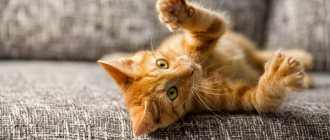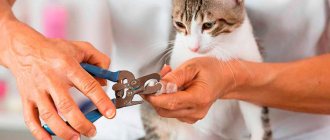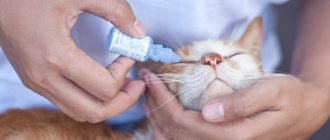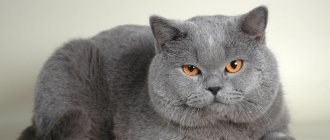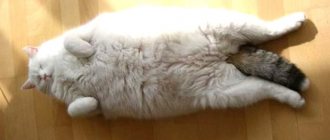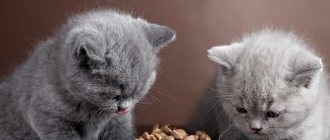5327Pavel
1
Experts have identified a large number of bone and paw diseases in cats, some of which appear in animals much more often than others. Some paw diseases in cats make themselves known early and can go away instantly if treatment is started on time. In case of hopeless forms, it is recommended to seek help from a specialist as soon as possible so that the veterinarian can prescribe competent treatment.
The most popular problems in cats and cats are:
- breaking, cracking and ingrown claws
- damage, cracks and foreign objects in the paw pads
© shutterstock
Problems must be eliminated, so the cat will feel out of danger, feel comfort and care from the owners, and will trust the person more.
Ingrown claws in cats
Cats need to scratch non-stop to keep their claws sharp and clean. When members of the cat family are unable to sharpen their claws, health problems occur. For pets, you need to install a scratching post at home so that cats can have the opportunity to stretch their claws without any problems.
Ingrowth occurs more often in cats that are not very active. Therefore, the owner needs to monitor the condition of the animal’s claws and maintain them in a normal form - trim off the excess so that the paw pads do not grow into the soft tissues. Because of this, the paw will hurt, and inflammation and even a purulent process may begin in the claw area due to the accumulation of dirt in this place. In this case, the veterinarian should prescribe medication for the cat.
If the problem is not treated, the inflammatory process will cause discomfort and pain to the animal, prevent the cat from moving normally, and the animal will limp. It is recommended to trim ingrown claws at home with special pliers, or use the services of a specialist.
Diagnostic methods
If your cat's pads are cracking, and the wound is bleeding and does not heal for a long time, you should not delay a visit to the veterinarian. After the initial examination, a sample is taken from the affected area for microscopic, cytological and histological examination. The sensitivity of the identified pathogen to antibiotics is also determined.
It is important that the doctor distinguishes the animal’s disease from pemphigus foliaceus in time.
There are other dangerous diseases in which the paw pads peel off and become an unnatural color. Therefore, differential diagnosis must be carried out, which will help exclude such pathologies:
- eosinophilic granuloma;
- neoplasia;
- pemphigus foliaceus;
- injury.
Chinchilla
The main coat color is white. The back, sides, head, ears and tail are lightly black. The white fur on the face and legs may be mixed slightly with black. The chin, ear tufts, belly, chest, inside of the legs and underside of the tail should be white, brown or cream in color. The paw pads are black or cat-colored. The eye color is bluish-green and the eyes are outlined in black.
· Blue chinchilla (main color is blue, the undercoat is pure white; the nose is brick-red with a blue frame, the paw pads are gray-blue);
· Chocolate chinchilla (basic color - chocolate, undercoat pure white; nose is brick-red with a chocolate frame, paw pads from cinnamon to chocolate);
· Lilac chinchilla (the main color is lilac, the undercoat is pure white; the nose is brick-red with a lavender-pink frame, the paw pads are lavender-pink).
Breaking off claws and cracks in pads
One of the common paw problems among representatives of the cat family is broken claws and the formation of cracks on the paw pads; this occurs as a result of injury or mechanical damage to the animal’s paw. When a crack appears on the claws, or they break off for any reason, this may be the beginning of purulent inflammation of the corolla, and then the claw will fall off on its own.
© shutterstock
In particularly advanced cases, the corolla and claws are removed surgically. It is necessary to monitor the condition of the cats’ claws, and if sharp ends are detected, remove them painlessly and apply an antiseptic for the wounds. For cracks and damage, a bath with a disinfecting effect is recommended; it helps relieve inflammation and eliminate the problem. In particularly severe cases, veterinary supervision is necessary.
Color-point (Pointed (Siamese) pattern) (rare)
This is the so-called “Siamese color” (sometimes “Himalayan”) when the main coat color is white (with shades), and the muzzle, ears, paws and tail are painted with spots of some other color (there are many color variations). Very unusual and beautiful color. Kittens are usually born white and darken as they age. Young cats have a much lighter body color than adults. The eyes must be sky blue, the nose and paw pads must match the color spots.
· Seal point: the coat color is warm and the markings are dark brown (seal coloration);
· Chocolate point (chocolate point): a very rare color, the coat is colored a pleasant ivory color, the markings are chocolate;
· Blue point: pale blue markings;
· Cream point: marks of a delicate cream color;
· Blue cream point: markings of light blue, evenly mixed with soft cream color. The nose can be blue-gray, pink or blue-gray with pink spots;
Pads to survive
Our beloved cats tiptoe through life. And the point is not in the beauty and grace of such a gait - people with mustaches hardly think about this. Simply walking and running on your toes increases the chances of a successful hunt - thus the swing becomes longer and the speed is higher.
In addition, the pads work as sound absorbers - it’s not without reason that they say: she walked in quietly, like a cat. The pads soften both the sound of a jump and the sound of a step, which is especially important when hunting. A cat that sneaks around on tiptoe is very difficult for potential prey to notice!
The small paw pads contain a large number of nerve endings that help assess temperature and surface texture, as well as sense unevenness, which helps maintain balance.
Also, these nerve endings very sensitively pick up the slightest vibration - this is what is associated with the ability of cats, and many other animals, to “predict” earthquakes. There is nothing mystical here; cats begin to show anxiety several hours before the first tremors, as they sense the slight vibration of the soil that precedes it.
28.11.2017
“O little queen without a kingdom, rootless conqueror, miniature lazy tigress, you catch a wave of love in the air as you walk, barely touching the ground with your paws, sniffing suspiciously at all objects, because everything seems dirty to you in contact with your unsullied paws, oh cat. "(Adriano Bacchella. Cats)
Cat's paws deserve the closest attention and a separate story, they are so important for all aspects of a cat's life.
They are cute and fluffy, soft and graceful - you just want to pet them (which is not always what our pets like)..
But a cat's paws are also a versatile and important part of a cat's body, helping it perform a variety of actions and increasing the animal's chances of survival in the wild.
Did you know that a cat uses its paws for many purposes:
- communication with humans and other animals
- checking the environment for hazards
- hunting and defense
- caring for your hair
- body temperature regulation
- clinging to objects and deft climbing
- shock absorption during jumps or falls
- food and drink
- complacency
This story provides some interesting facts about cats' paws, their pads and claws, and how skillfully the animals use them.
1. A cat normally has five toes on its front paws and four on its back paws, unless it is multi-digitated (six or more toes)
The multi-fingered mutation in cats is called polydactyly (from the Greek poly, meaning many, and dactylos, fingers).
Multi-fingered cats are also called “Hemingway’s cats” because a large flock of six-fingered cats lived in the famous writer’s house.
Polydactyly is a genetic inheritance, not a defect. These cats perceive this as a positive trait and use the extra toe to improve stability and agility. There is a belief that polydactic cats bring good luck and happiness to the house.


